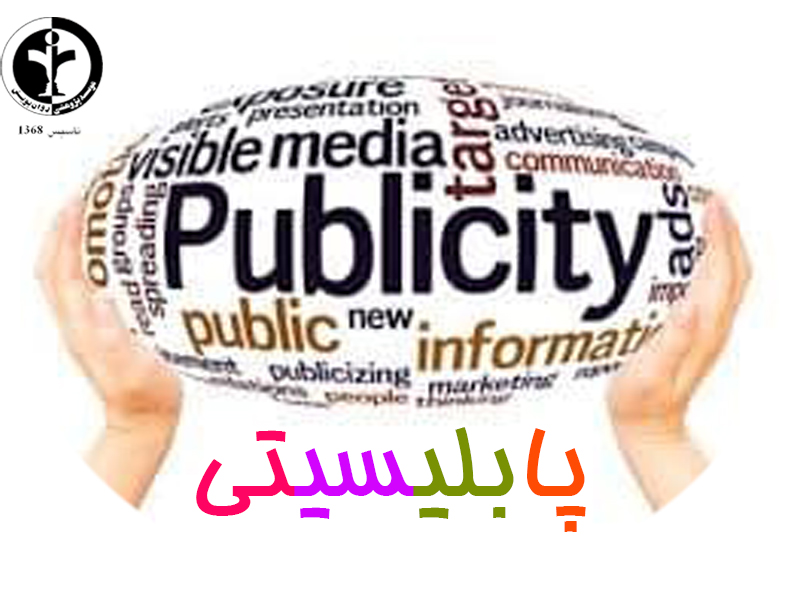پابلیسیتی – تعاریف – ویژگیها – اهداف
Publicity: Definitions, Characteristics, Importance and Objectives
Publicity is also a way of mass communication. It is not a paid form of mass communication that involves getting favourable response of buyers by placing commercially significant news in mass media. Publicity is not paid for by the organisation. Publicity comes from reporters, columnists, and journalists. It can be considered as a part of public relations.
Publicity involves giving public speeches, giving interviews, conducting seminars, offering charitable donations, inaugurating mega events by film actors, cricketers, politicians, or popular personalities, arranging stage show, etc., that attract mass media to publish the news about them.
Publicity is undertaken for a wide range of purposes like promoting new products, increasing sales of existing product, etc. It also aimed at highlighting employees’ achievements, company’s civic activities, pollution control steps, research and development successes, financial performance, its progress, any other missionary activities, or social contribution.
Definitions:
Publicity has been defined as:
۱. William J. Stanton:
“Publicity is any promotional communication regarding an organisation and/or its products where the message is not paid for by the organisation benefiting from it.”
۲. Philip Kotler:
“Non-personal stimulation of demand for the product or service, or business unit by placing commercially significant news about it in public medium or obtaining favourable presentation of it upon radio, television, or stage that is not paid for by the sponsor.”
Characteristics of Publicity:
Key characteristics of publicity have been briefly described in following part:
۱. Meaning:
Publicity is not a paid form of mass communication that involves getting favourable response of buyers by placing commercially significant news in mass media. It involves obtaining favourable presentation upon radio, newspapers, television, or stage that is not paid for by the sponsor.
۲. Non-paid Form:
Publicity is not a paid form of communication. It is not directly paid by producer. However, it involves various indirect costs. For example, a firm needs some amount for arranging function, calling press conference, inviting outstanding personalities, decorating of stage, other related costs, etc.
۳. Various Media:
Mostly, publicity can be carried via newspapers, magazines, radio, or television. For example, in case a product is launched by popular personality in a grand function, the mass media like newspapers, television, radio, magazines, etc., will definitely publicize the event.
۴. Objectives:
Sales promotion is undertaken for a wide variety of purposes. They may include promotion of new product, pollution control, special achievements of employees, publicizing new policies, or increase in sales. It is primarily concerns with publishing or highlighting company’s activities and products. It is targeted to build company’s image. In a long run, it can contribute to increase sales.
۵. Control of Producer:
Company has no control over publicity in terms of message, time, frequency, information, and medium. It comes through mass media like radio, newspapers, television, etc. It is given independently by the third party. It is presented as a news rather than propaganda.
۶. Credibility/Social Significance:
Publicity has high degree of credibility or reliability as it comes from mass media independently. It is given as news for social interest. It has more social significance compared to other means of market promotion.
۷. Part of Public Relations:
Publicity is a part of broad public relations efforts and activities. Public relations includes improving, establishing, and maintaining direct relations with all publics. Publicity can help improve public relations.
۸. Costs:
Publicity can be done at much lower cost than advertising. Company needs to spend a little amount to get the event or function publicized.
۹. Effect:
Publicity message is more likely to be read, viewed, heard, and reacted by audience. It has a high degree of believability as it is given by the third party.
۱۰. Repetition:
Frequency or repetition of publicity in mass media depends upon its social significance or the values for news. Mostly, it appears only once.
Importance of Publicity:
Like advertising and sales promotion, sales can be increased by publicity, too. Publicity carries more credibility compared to advertisement. Publicity is cost free; it doesn’t involve direct cost. Publicity offers a lot of benefits to the producers and distributors.
Importance of publicity can be made clear from the below stated points:
۱. Publicity is an effective medium to disseminate message to the mass with more credibility. People have more trust on news given by publicity.
۲. The credibility level of publicity is much higher than advertising and other means of market promotion. People express more trust on what the third party independently says. It appears directly through newspapers, magazines, television, or radio by the third party. It is free from bias.
۳. It provides more information as the valuable information is free from space and time constraints. Similarly, publicity takes place immediately. No need to wait for time or space in mass media. It enjoys priority.
۴. The firm is not required to pay for publicity. The indirect costs related to publicity are much lower than other means of promotion.
۵. It is a part of public relations. It is free from exaggeration; it carries more factual information about company. It is more trustable. It helps establish public relations.
۶. Generally, publicity covers the varied information. It normally involves name of company, its goods and services, history, outstanding achievements, and other similar issues. The knowledge is more complete compared to advertisement.
۷. Publicity directly helps middlemen and sale persons. Their tasks become easy. Publicity speaks a lot about products on behalf of middlemen and salesmen. Sellers are not required to provide more information to convince the buyers.
۸. It is suitable to those companies which cannot effort the expensive ways to promote the product.
۹. Publicity increases credit or fame of the company. Publicity on company’s assistance in relief operations during flood, earthquake, draught, and other natural calamities highlights its name and social contribution in mass media. People hold high esteem to this company.
۱۰. Publicity can be used by non-commercial organisations/institutes like universities, hospitals, associations of blinds or handicaps, and other social and missionary organisations. They can publicize their noble works by the medium of publicity.
Objectives of Publicity:
Publicity is aimed at a number of objectives.
The most common objectives of publicity have been discussed in brief as under:
۱. Building Corporate Image:
Through publicity, a company can build or improve its corporate image. People trust more on what press reporters, columnists, or newsreaders say via mass media independently than what the company says. Publicity highlights the company’s name and operations. It popularizes the name of the company.
۲. Economy:
It is a cost saving medium. Here, a company is not required to pay for message preparation, buying space and time, etc. The cost involved is much lower than other means of market promotion. Financially poor companies may opt for publicity.
۳. Assisting Middlemen and Salesmen:
Publicity can help middlemen and salesmen in performing the sales-related activities successfully. Information conveyed through publicity speaks a lot of things on behalf of sellers. Publicity makes selling tasks much easier.
۴. Information with High Creditability:
Sometimes, publicity is targeted to disseminate information more reliably. Customers do not express doubts on what publicity appeals. Customers assign more value to information supplied by mass media via publicity than by the advertisement.
۵. Removing Misunderstanding or Bad Image:
Company can defend the product that has encountered public problems. In many cases, publicity is aimed at removing misunderstanding or bad impression. Whatever a publicity conveys is more likely to be believed.
۶. Building Interest on Product Categories:
Publicity attracts attention of buyers. Due to more trusted news, people build interest in various products and activities.
۷. Newsworthiness Information:
Publicity publicizes the fact in an interesting ways. Publicity is eye-catching in nature. People do not skip the news presented by publicity that more likely happens in case of advertising. For example, when a new product is launched by the distinguished personalities like film star, eminent artist, or cricketer in a grand function, the product becomes popular within no time
پابلیسیتی در مقابل تبلیغات
Advertising Vs Publicity
January 5, 2019 by Prachi M Leave a Comment
The terms advertising and publicity are used interchangeably by many of us. But there is a considerable difference between the two. The critical difference between the two is that; former is a paid promotion of products done with the aim of increasing sales volume. However, the latter is an unpaid promotion through a third party aimed at creating a buzz or revealing a public interest story.
However, both advertising and publicity are used as a promotional tool by companies. Each of them has a different purpose and way of marketing the brand and its products. When advertising develops a brand name, publicity may create a negative impact on sales of a product.
Content: Difference Between Advertising and Publicity
۱. Difference and Comparison
۲. Example
۳. What is Advertising?
۴. What is Publicity?
۵. Types
۶. Objectives
۷. Advantages
۸. Disadvantages
۹. Summary
Difference and Comparison
Basis Advertising Publicity
Meaning Advertising is a sponsored promotion done with the objective of selling the product. Publicity is a free activity done for circulating information or news.
Sub-part of Promotion mix Public relations
Nature Impersonal and general Both personal and impersonal
Control Company Third party
Target Audience Prospective customers or buyers Public in general
Initiative Initiated by the company Initiated by the media
Cost Involved Involves advertising expenses Involves no or very less expenditure on arrangements
Impact Increase in sales volume Brings out negative or positive aspect of a product or brand
Benefit Builds brand image Creates goodwill and develops trust
Audience’s Perception Mere sales promotion Source of genuine information
Duration or Longevity Runs repetitively Featured only once
Creativity Creative ways are used to draft and deliver the message Creativity is used to create a buzz or news on media
Credibility Less Comparatively high
Sponsorship Sponsored Not sponsored
Follow Up Results can be measured in terms of sales volume Difficult to measure the result in numbers
Example
Advertising:
Let us understand advertising with the advertisement for P&G on cleaning and household goods.
This ad portrayed the life of athletes and their mothers who are behind their success. The mothers push their children at every step of life to achieve success. In their athletic journey, the mothers have to do a lot of cleaning and other household work. In which P&G is presumed to make their job easier.
The advertisement was quite powerful and influential in creating the desired impact on the audience.
Publicity:
One of the best examples of publicity is the launch of cosmetic range by a billion-dollar brand Benckiser for Indian women was featured as the cover story of India Today magazine, in the year 1996.
The magazine created a buzz for the thirty new cosmetic products which Benckiser was going to launch the next year in India. This publicity stunt became the talk of the town, creating a positive image for the brand.
The publicity is a more reliable form of marketing where the credibility is high and more information about the product is disclosed.
What is Advertising?
Advertising is a paid marketing strategy followed in seeking the attention of potential customers towards a product by drafting a creative message and circulating it among the mass audience through different media sources.
Characteristics: To understand the concept of advertising in detail, let us go through its features:
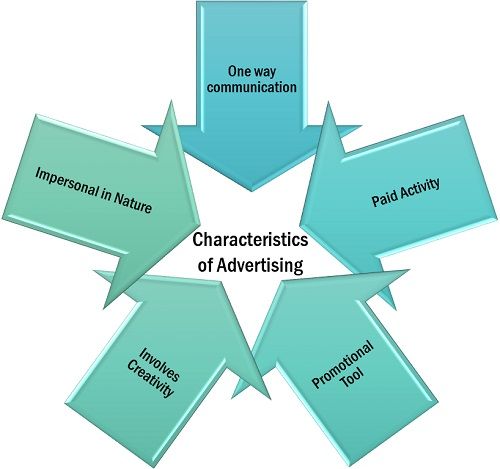
:
• One way communication: Advertising can be termed as a one-way communication process. Here, the company introduces the prospective customers to its product through various media sources, and the customer’s feedback or response cannot be taken.
• Paid Activity: Advertising activities right from the creation of an advertisement, i.e. the message to the buying of a media slot for making the ad live, everything requires finance.
• Promotional Tool: It is purposefully done as a strategy of promotion mix with the aim of generating sales and increasing the customer base for a product.
• Involves Creativity: Since it is a one-way communication, it has to be highly influential. Therefore to leave an impact on the audience, the message, as well as its presentation, must be very creative and innovative.
• Impersonal in Nature: Advertising is usually impersonal, i.e. it is done with the aim of targeting a massive audience through the standard media like television, newspaper, radio, etc.
What is Publicity?
Publicity is the means of unpaid promotion through the third party usually media which features the complete information about the product or the brand in the form of news or buzz.
Characteristics: Publicity is a useful tool, to know more about it, let us understand its features:
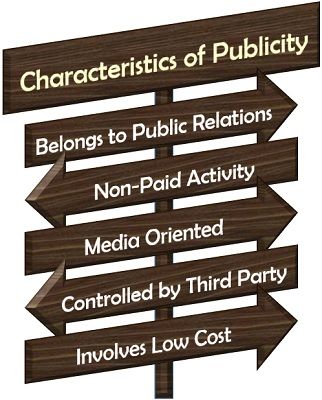
• Belongs to Public Relations: Publicity is a part of public relations since its efforts are directed towards establishing and maintaining strong business relations.
• Non-Paid Activity: It is a free promotional activity done by a third party to spread information about the product.
• Media Oriented: Publicity is driven and initiated by the press or the media to create news about the product.
• Controlled by Third Party: The message to be delivered through the press release or news or other media is controlled by the third party, i.e. the publisher or the media house.
• Involves Low Cost: Publicity may include the minimal cost incurred on arrangements of publicity events.
Types of Advertising
Advertising can be categorized by the medium used for the purpose. Following are the different ways of
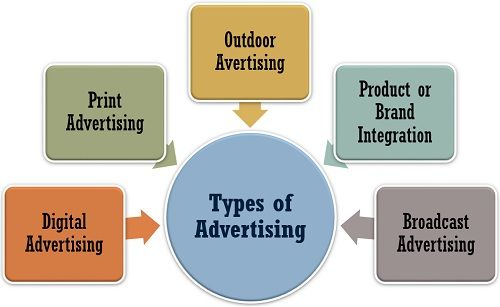
advertising:
• Digital Advertising: Digital advertising includes social media like Facebook, Twitter, Instagram; emails like Yahoo mail and Gmail; and other digital platforms. It is used to put advertisements and target potential customers.
• Print Advertising: The advertisements in written form such as in the newspapers, journals, magazines, pamphlets, brochures, etc. are considered as print advertising.
• Outdoor Advertising: The companies advertise their product on roadside banners, flags, hoardings and wraps.
• Product or Brand Integration: Products are promoted through entertainment channels running on television, youtube video, etc.
• Broadcast Advertising: Usually in the video or audio form, the commercials on television and radio are known as broadcast advertising.
Types of Publicity
The different ways in which publicity is done determines its type. Each of which is explained below:
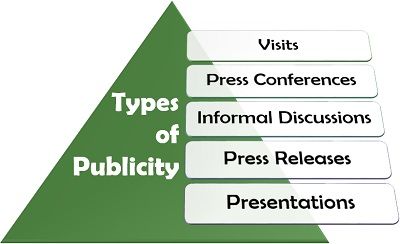
• Visits: The third party, i.e. press or media, conduct a visit to the business outlets for promoting innovative products.
• Press Conferences: The company’s representatives give an interview to the journalists regarding their product or brand in a press conference which is further featured in media.
• Informal Discussions: Oral publicity or word of mouth is one of the most potent ways of publicity. If the third party share its experience with the company with the potential customers, it becomes easy for the company to gain their trust.
• Press Releases: The public relations professional frames out a short story on the innovative product to be published by the journalist as news reports.
• Presentations: The company introduces the media to its new product through a demonstration, lecture or speech to be featured by them.
Objectives of Advertising
The ultimate purpose of advertising for the companies is to draw customers’ attention towards their product. Following are its various objectives:

• Advertising aims at promoting the product by making the audience aware of the product features.
• It is done to pursue potential customers to buy the products.
• The company tries to build a strong and confident image of its brand and its product in front of potential customers.
Objectives of Publicity
Publicity aims at providing long-term benefits to the company. The other purposes of adopting this
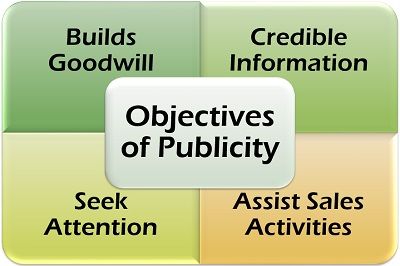
strategy are as follows:
• Publicity creates goodwill of the company since it is more trusted and relied upon by the customers.
• The consumers assume that the information so provided is more genuine and holds high credibility.
• Publicity usually creates a buzz or talk of the town, seeking attention from the public.
• It is an accelerating activity for the sales function, ultimately improving product sales.
Advantages of Advertising to the Customers
Advertising helps the customers in decision making since they have a variety of similar products to compare and choose from. They become aware of the new products offered by the company and get educated about its features and usage. The customers can view better quality products since advertisements are mostly carried out by big brands having superior product range.
Advantages of Advertising to the Company
For the company, advertising is a means of building brand image in the market. It emphasizes those product features which differentiate it from its competitors, thus facilitating product differentiation. Moreover, it helps the companies to reach out mass audience who can be considered as potential customers for the company. It also increases the sales volume by encouraging more and more customers to buy the product.
Through advertising, the company promote its new product by generating a vast customer base. It can influence the audience in such a way that the potential customers can be converted into buyers.
Advantages of Publicity
Publicity being a free practice is more cost-efficient. It is considered to be a more trustworthy source of information by the customers. It is also a source of detailed information about the product and the brand.
Publicity is a useful promotional tool having a high number of readers or viewers since the product information is in the News form. It is a faster means of promotion since it has a significant number of genuine audiences. It helps the company to become famous and go viral. Thus, it helps in building strong business relations.
Disadvantages of Advertising
Advertising of products involves a lot of expenses which are recovered from the customers by increasing the per-unit cost of the product. Therefore, it also seems to be unaffordable by small businesses.
The customers get confused about what to buy due to the numerous options available to them. Advertising sometimes misleads consumers by providing false information to the audience.
Advertising has no product selection criteria based on the quality, which means the false promotion of inferior products can even take place. It is a tool for grabbing customer’s attention, but it doesn’t lead to customer retention. Retention of customers depends upon their buying experience and product worthiness.
Disadvantages of Publicity
Publicity can be either way, good or bad. Bad publicity can adversely affect the company by ruining the brand image. It may even decrease the sales volume drastically, as an impact of bad publicity.
In the case of bad publicity, loyal customers may lose trust over the brand and its products. The company may also lose its associates and business partners due to its poor reputation in the market.
Summary
By the above comparison chart, the differences between advertising and publicity are summarized in the following points:
۱. Advertising is a sponsored promotion done for the purpose of selling the product, whereas publicity is a free activity aiming at spreading information or news.
۲. When advertising is a strategy belonging to the promotion mix, publicity can be seen as a part of public relations.
۳. Advertising activities are impersonal addressing the mass audience; publicity can be both personal or impersonal.
۴. In advertising, the company has full access and control over the message and how it is to be presented. In publicity, the company holds minimal control over the message and its circulation, whereas the third-party majorly controls the activities.
۵. The target audience in case of advertising is the potential customers, and it is considered as a sales function. Whereas, in publicity, the target audience is the public, i.e. all the people associated or looking for a future association with the company. These include employees, sales personnel, customers, business partners, etc.
۶. The former is a strategy adopted and initiated by the company itself. However, the latter is the media or press commenced activity.
۷. Advertising involves huge cost spent on the creation of the message and buying off the media slot and making the ads live. On the contrary, publicity is a free activity or may involve some minimal expenses incurred in making the arrangements.
۸. The former increases the sale of the product, whereas the latter may have a positive or a negative impact on the company’s image and reputation.
۹. Advertising builds the right image of the product and the company in the market. Publicity, on the other hand, creates the goodwill of the brand by developing trust among the public.
۱۰. The audience, i.e. the smart potential buyers assume advertising just as a sales promotion activity. Whereas, publicity is taken as a source of factual information by the public.
۱۱. If the company’s advertising budget allows, the company can run ads repetitively. On the contrary, publicity is done through news, press release or reviews is featured only once.
۱۲. Creativity is essential in both activities. The only difference is that; former uses creativity to draft and deliver the message, whereas; the latter find out innovative ways to create buzz or news on media.
۱۳. Advertising is considered to be less credible and reliable, whereas publicity holds high credibility due to third party promotion.
۱۴. The former is run by identified sponsors, but the latter requires no sponsorship.
۱۵. The result of advertising can be easily measured regarding the sales volume; however, the same is quite tricky in case of publicity.
For the above differences, we can analyze that advertising is a good strategy if the company aims at boosting up sales in a short period. It can also be used to launch a new product in the market successfully.
But if the company has the objective of creating goodwill for its brand in the long run along with building strong relations with the people associated with it, it must adopt the strategy of publicity.
Copyright © ۲۰۲۱ ·
